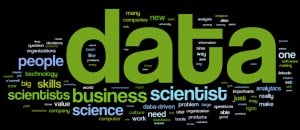Often when we embark on a new experience, we have to learn a new language. Suppose you’re a new parent and you have to learn and understand things like Boppy, Bumbo, bassinet, bottle and burp. Although these are simple words starting with a B, they are part of the language of a whole new world. It’s overwhelming at times, but we learn and adjust on our way to becoming an awesome parent.

Business Intelligence (BI): is the set of techniques and tools for the transformation of raw data into meaningful and useful information for business analysis purposes.
A BI initiative includes five steps: 1) scope – keep it narrow to start, 2) collect data, 3) clean data, 4) analyze data, 5) communicate and train. Begin with the end in mind in the scoping phase and identify the high value business questions – the answers to which will position your organization for success. The quality of the answers you receive with data is correlated with the quality of the questions you ask.
Data Analytics: (techtarget.com): is the science of examining raw data with the purpose of drawing conclusions about that information.
Although there is ambiguity and confusion around this term, we consider it to be a synonym for Business Intelligence.
Data Analysis: is a process of inspecting, cleaning, transforming, and modeling data with the goal of discovering useful information, suggesting conclusions, and supporting decision making.
This term is actually where you land when searching ‘data analytics’ on Wikipedia. In essence, the key difference at the definition level is the emphasis on using clean data instead of raw data for drawing conclusions. DSK’s standard processes enforce cleaning your data when launching a BI project.
Big Data: is an all-encompassing term for any collection of data sets so large and complex (in terms of variety, velocity and volume) that it becomes difficult to process using traditional data processing applications. Big data includes both structured (relational) and unstructured (text, video, etc,)
Many associations will start to work with big data within the next 3-5 years. The tools are improving and it is becoming less expensive and complex.
Data mart: is a subset of the data warehouse that is usually oriented to a specific business line or team.
When we implement solutions, we construct data mart(s) outside of your production AMS environment and connect the power users directly to it using Tableau Software for data visualization. It can also serve as a central repository of additional data sources such as Google Analytics, third party event registration or exhibit data, or expense data from your general ledger.
Data driven: means that progress in an activity is compelled by data, rather than by intuition or personal experience. It is often labeled as the business jargon for what scientists call evidence based decision making.
DSK prefers the term ‘data guided’. We believe it is essential to use data to make decisions yet even the most complex analytics require human insight to guide the process. After all it is people who decide what to measure and people who take action on the results of the analysis. Your association’s leaders and board members have knowledge and experience which should be combined with data for reduced risk in decision making.
Data Visualization: involves the creation and study of the visual representation of data, meaning information that has been abstracted in some schematic form, including attributes or variables for the units of information.
The human brain is able to see faster than it can think – 3x faster, in fact! Using visualizations (graphics/pictures) to represent data instead of charts is more productive and will yield insights that would not be quickly evident in a table of numbers.
All these terms have a common thread – data. You use data in your daily life, such as deciding between Britax and BabyGanics, so why not use it at work too? Make data a part of the culture and watch your organization (and your children) grow!



